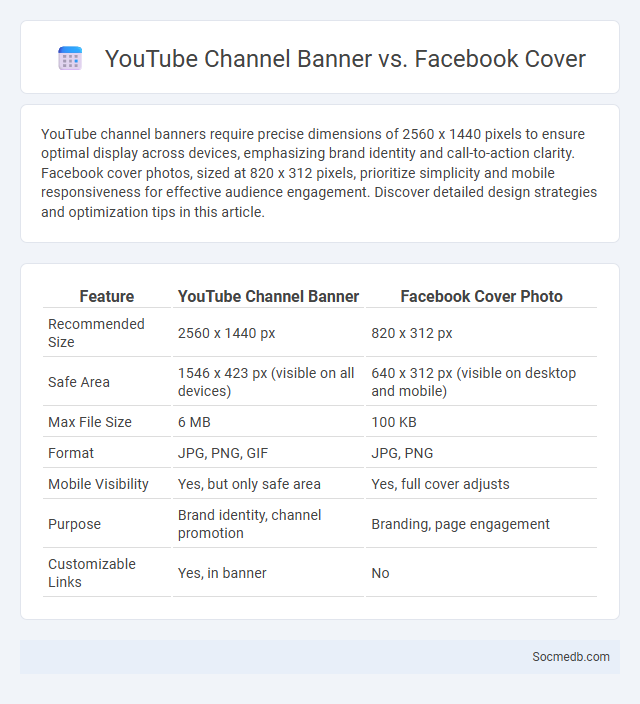
Photo illustration: YouTube Channel Banner vs Facebook Cover
YouTube channel banners require precise dimensions of 2560 x 1440 pixels to ensure optimal display across devices, emphasizing brand identity and call-to-action clarity. Facebook cover photos, sized at 820 x 312 pixels, prioritize simplicity and mobile responsiveness for effective audience engagement. Discover detailed design strategies and optimization tips in this article.
Table of Comparison
| Feature | YouTube Channel Banner | Facebook Cover Photo |
|---|---|---|
| Recommended Size | 2560 x 1440 px | 820 x 312 px |
| Safe Area | 1546 x 423 px (visible on all devices) | 640 x 312 px (visible on desktop and mobile) |
| Max File Size | 6 MB | 100 KB |
| Format | JPG, PNG, GIF | JPG, PNG |
| Mobile Visibility | Yes, but only safe area | Yes, full cover adjusts |
| Purpose | Brand identity, channel promotion | Branding, page engagement |
| Customizable Links | Yes, in banner | No |
Introduction to Social Media Banners
Social media banners serve as a pivotal visual element for branding and engagement across platforms like Facebook, Twitter, and LinkedIn. Optimizing banner dimensions and incorporating high-resolution images with clear messaging enhances visibility and click-through rates. Effective social media banners utilize consistent color schemes and fonts aligned with brand identity to capture audience attention quickly.
What is a YouTube Channel Banner?
A YouTube channel banner is the large, customizable header image that appears at the top of a YouTube channel page, serving as a visual representation of the channel's brand and identity. This banner plays a crucial role in attracting viewers, promoting the channel's theme, and providing essential information like social media links or upload schedules. Optimizing the YouTube channel banner with correct dimensions (2560 x 1440 pixels) ensures it displays perfectly across all devices, enhancing user engagement and channel professionalism.
Understanding Facebook Cover Photos
Facebook cover photos serve as prominent visual elements that represent personal identity or brand presence, typically displayed at the top of a profile or business page. Optimal dimensions of 820 x 312 pixels ensure clarity and proper display across devices, while high-resolution images enhance user engagement and professional appearance. Incorporating consistent branding, relevant themes, and eye-catching visuals improves audience retention and reinforces social media marketing strategies.
Channel Banner: Platforms and Purposes
Channel banners on social media platforms like YouTube, Facebook, and Twitch serve as crucial brand identifiers, optimizing your visual presence to attract and retain subscribers. Tailored banners reflect platform-specific dimensions and audience preferences, enhancing engagement by clearly conveying your channel's purpose or theme. Designing your channel banner with platform guidelines ensures maximum visibility and establishes a professional online identity that supports your content strategy.
Key Differences Between YouTube and Facebook Banners
YouTube banners are designed with a 2560 x 1440 pixel resolution, emphasizing mobile and TV compatibility, while Facebook banners prioritize a 820 x 312 pixel size suitable for desktop and mobile views. YouTube banners support clickable elements and links, enhancing channel branding and direct traffic, whereas Facebook banners primarily focus on visual appeal without embedded links. The platform-specific design guidelines impact how content is displayed, with YouTube allowing more creative freedom and dynamic branding space compared to Facebook's more restrained format.
Optimal Banner Dimensions and Design Guidelines
Optimal banner dimensions for social media vary by platform, with sizes like 820x312 pixels for Facebook cover photos and 1500x500 pixels for Twitter headers ensuring crisp visuals. Design guidelines emphasize high-resolution images, clear branding, and minimal text to capture attention and enhance engagement. Tailoring your banner to platform-specific requirements improves your brand's visibility and maximizes the impact of Your social media presence.
Branding Strategies for Banners Across Platforms
Effective branding strategies for social media banners involve consistent use of color schemes, logos, and typography tailored to each platform's dimensions and audience behavior. Utilizing high-resolution images and concise messaging enhances visual impact while maintaining brand identity across Facebook, Instagram, Twitter, and LinkedIn. Optimizing banner designs for mobile and desktop formats ensures maximum engagement and reinforces brand recognition.
Best Practices for Channel and Cover Banners
Creating visually compelling and properly sized social media channel and cover banners enhances brand visibility across platforms like Facebook, Twitter, and LinkedIn, where optimal dimensions range from 820x312 pixels to 1500x500 pixels. Use high-resolution images, consistent brand colors, and clear typography to convey your message effectively, while leaving adequate space for profile pictures and call-to-action elements. Your banner should align with your overall branding strategy, ensuring instant recognition and engagement from your audience.
Common Mistakes to Avoid in Social Media Banners
Social media banners often suffer from overcrowded text and poor image resolution, which diminish user engagement and brand credibility. Ignoring platform-specific size requirements can lead to distorted visuals that fail to attract the target audience. Consistent branding, clear messaging, and optimized dimensions are essential to maximize the impact of social media banners.
Conclusion: Choosing the Right Banner for Your Brand
Selecting the right social media banner significantly enhances brand visibility and engagement by aligning visual elements with target audience preferences. Utilizing high-resolution images, consistent color schemes, and clear messaging tailored to platform-specific dimensions maximizes impact and professionalism. Effective banner design ultimately drives brand recognition and fosters stronger connections across digital channels.
 socmedb.com
socmedb.com